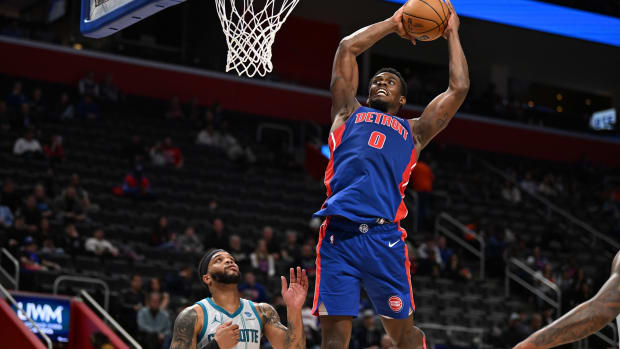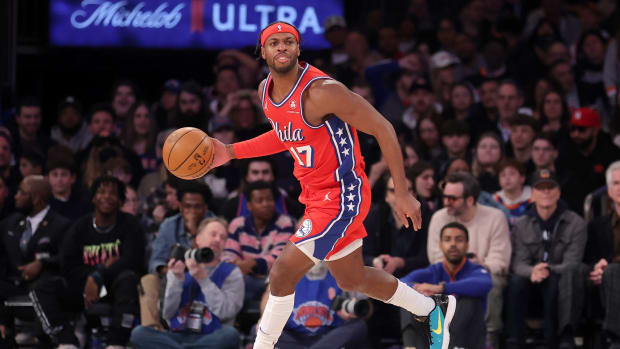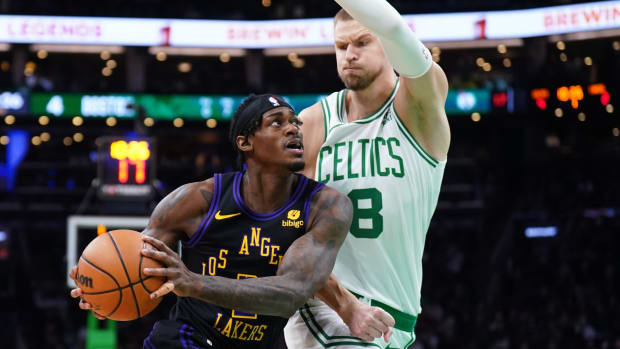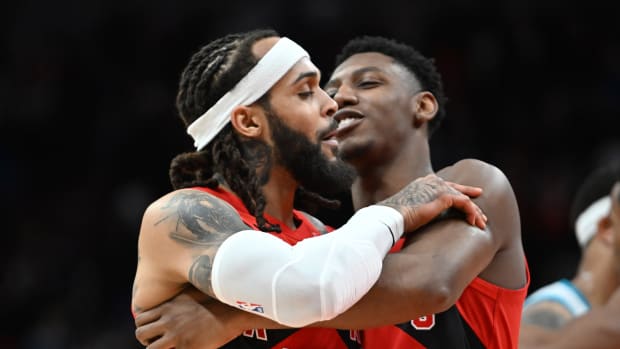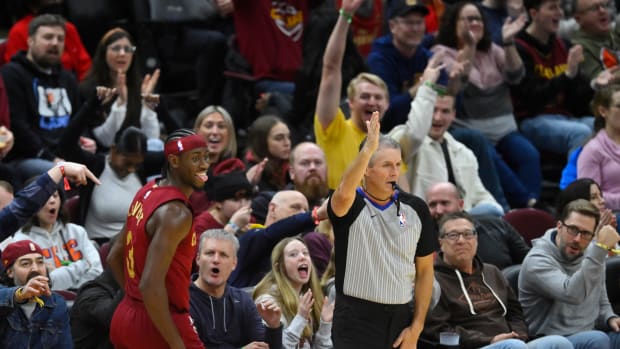The Potential Legal Consequences of Bryan Colangelo's Twitter Controversy
A stunning report by The Ringer’s Ben Detrick on Tuesday night claims that Philadelphia 76ers president of basketball operations Bryan Colangelo has used five burner Twitter accounts to anonymously criticize current and former 76ers players as well as to sharply rebuke head coach Brett Brown and Colangelo’s predecessor, Sam Hinkie. The accounts also shared what could be considered 76ers’ proprietary information—including the 76ers plan to acquire the No. 1 overall pick in the 2017 draft from the Boston Celtics—and disclosed nonpublic medical information about former 76ers forward Jahlil Okafor.
Detrick explains that his scoop came from an anonymous person who used an “open-source data analysis tool” to detect unusual commonalities and “linguistic quirks” among the five accounts linked to Colangelo. These Twitter handles also exhibited similarities in accounts they follow.
76ers To Investigate Bryan Colangelo's Alleged Use of 'Burner' Twitter Accounts
Detrick’s story details how these accounts have expressed certain recurring themes. Those themes include impassioned defense of Colangelo’s decision-making and ridicule of Hinkie as a basketball executive and person. Hinkie resigned as 76ers president of basketball operations and general manager in April 2016, four days before the team hired Colangelo to replace him. Hinkie’s controversial strategy, dubbed “the process” and reliant on analytics, led the 76ers to amass top draft picks and accumulate salary cap space while losing games. Many fans and media—as well as 76ers star Joel Embiid—have attributed the 76ers success over the last two seasons more to Hinkie’s foresight and vision than to Colangelo’s decisions.
The accounts dig at Hinkie to the point where if Colangelo wrote the tweets, they would suggest he is envious of Hinkie. For instance, @Enoughunkownsources tweeted, “I have no respect for Hinkie’s martyrdom bcs it is orchestrated by him behind the curtains via all the bloggers he cultivated with leaks,” while Eric jr/@AlVic40117560 tweeted “[Bryan Colangelo] has done nothing but clean up hinkie’s mess . . . Hinkie got great pieces but could [not] make the puzzle work.” Later, in a Tweet about Detrick’s story, user @Fantasource found Eric jr mocking Hinkie—who guest lectured at Stanford after leaving the 76ers—by tweeting at him, “hey . . . how is the teaching at Stanford going?”
In a statement released through the 76ers, Colangelo mostly denies Detrick’s report. Colangelo acknowledges he uses one of the five handles, @Phila1234567, “to monitor our industry and other current events.” Yet, crucially, Colangelo insists that he has “never posted anything whatsoever on social media” and has never tweeted under the other four Twitter handles. Consistent with Colangelo’s claim, the @Phila1234567 handle has never tweeted and is set to private. On the other hand, it is seemingly suspicious that, according to Detrick, three of the Twitter accounts “went dark simultaneously” shortly after Detrick contacted the 76ers for a statement.
If Colangelo authored certain tweets attributed to the accounts, he and the 76ers could encounter legal problems as well as problems with the NBA.
The 76ers have launched an investigation and the NBA could, as well—especially if pressured by players
The accusations against Colangelo are damaging not only for him, but also for the 76ers and the NBA. The idea that a team’s general manager would employ anonymous social media accounts to harass and ridicule his own players is highly embarrassing to both the general manager and the employing team. Many would regard such conduct as childish if not pathetic.
Colangelo is also now anchored to his side of the story. He has gone on record to categorically deny critical aspects of Detrick’s report and he has used the 76ers’ communications department to issue that denial. In explicitly saying that he has “never posted anything whatsoever on social media,” Colangelo has left no wiggle room to later change his narrative. He can’t claim that he somehow “misunderstood” the way social media works or “misremembered” the past. Colangelo is either telling the truth or lying, and there is no middle ground.
Per multiple media sources on Tuesday, the 76ers have launched an investigation into the allegations. This is not surprising. 76ers owner Josh Harris has no doubt concluded that an investigation is warranted to determine fact from fiction. He probably has reasoned that unless debunked, the allegations will adversely impact Colangelo’s ability to perform his job functions on behalf of the franchise. To that point, if the general consensus becomes “Colangelo is lying about the Twitter accounts,” Colangelo’s integrity would be compromised and the 76ers could suffer as a result.
For instance, other general managers may regard Colangelo as untrustworthy. They may then become less inclined to engage in trade talks with him—especially if they worry that their private conversations and confidential decisions about player physicals could surface on Twitter.
Joel Embiid Gave Internet an Epic Response to Bryan Colangelo Burner Account Report
For their part, players would be much less inclined to play for the 76ers if they believed that Colangelo could anonymously badmouth them on social media or surreptitiously spread damaging rumors about their character or health. Along those lines, Colangelo’s ability to be trusted by prized free agent players—including, possibly, LeBron James—could become seriously jeopardized to the point where the 76ers are damaged as well.
The 76ers also have reason to investigate if any company property, including company issued computers or iPhones, may have been used by Colangelo to engage in conduct that harms the franchise. As explored below, such conduct would make it more possible for Harris to fire Colangelo “for cause.”
At this point, it is unclear how the 76ers investigation will work and the extent to which it will be “independent.” The 76ers would be wise to retain outside attorneys, with no ties to the team, to conduct the investigation. The more independent the investigation is structured, the less likely the NBA will decide that a league-run investigation is also warranted. In February, the Dallas Mavericks quickly assembled an independent investigation, led by out-of-state attorneys who possess impressive credentials and no ties to either the Mavericks or owner Mark Cuban, in response to findings by SI’s Jon Wertheim and Jessica Luther concerning workplace misconduct. Had the Mavericks not taken such action, the NBA would have been more likely to launch its own investigation.
The NBA is also a meaningful factor in how the 76ers conduct their investigation and whether any actions could be taken against Colangelo and the 76ers. The league’s constitution makes clear that NBA commissioner Adam Silver can severely punish any franchise or team employee who, in Silver’s opinion, is guilty of conduct that damages the interests of the NBA. A team general manager who secretly moonlights as a player critic on Twitter is, minimally, embarrassing. It may prove more than that. Particularly if pressured by the National Basketball Players’ Association, the NBA could decide that such conduct rises to the level of damaging the league’s relationship with players and the union. Indeed, the NBPA could demand the NBA examine whether team executives are maligning players’ interests in ways that constitute breaches of those executives’ fiduciary duties to their teams and the league as a whole. Such misconduct would raise potential labor law disputes. Especially since damaging commentary about a player's health and ethics could adversely impact his future earnings as an NBA player and his potential as a product endorser.
The NBA may also be concerned about the unintended consequences of a general manager recklessly disclosing team-related information on social media. Any disclosures that reflect on a player’s availability and performance could potentially be useful to bettors. As Larry Coon, the well-known NBA analyst and general manager of Sports Business Classroom tells SI.com, the NBA’s 2017-18 Operations Manual contains a “no tipping” provision. The provision expresses that employees of NBA teams “may possess confidential information that would be of interest to people associated with gambling.” With that in mind, the no-tipping provision forbids NBA team employees from divulging any “confidential information to anyone unless the employee is certain that the person has a legitimate need for the information.” Coon notes that while there is no reason to believe that Colangelo would have tried to communicate with bettors, it could be possible that “gamblers knew Colangelo himself was posting through sock puppet account(s), and therefore his posting of confidential information through those accounts potentially constituted tipping.” This possibility will certainly be of interest to the NBA—especially in light of the U.S. Supreme Court’s recent decision to allow all states to authorize sports betting.
Exclusive: Inside the Corrosive Workplace Culture of the Dallas Mavericks
To that end, there are two key provisions from the league constitution concerning a possible investigation into Colangelo and, by extension, the 76ers.
First, Article 35A of the constitution would authorize Silver to suspend Colangelo for any length of time and/or fine him up to $1 million. Such a punishment would be appropriate if Silver concluded that Colangelo engaged in “conduct prejudicial or detrimental to the Association.” Second, Silver could refer to Article 24, which contains the “best interests of the NBA” provision. It expresses that the commissioner is “charged with protecting the integrity of the game of professional basketball and preserving public confidence in the League.” The best interests provision makes clear that “when a situation arises which is not covered in the Constitution and By-Laws, the Commissioner shall have the authority to make such decisions, including the imposition of a penalty, as in his judgment shall be in the best interests of the Association.” Article 24 authorizes a suspension of any length, a fine of up to $2.5 million and the forfeiture of draft picks.
Colangelo’s employment with the 76ers and trade secrets
While Colangelo has denied the more damaging aspects of Detrick’s report, if evidence surfaces that corroborates Detrick and refutes Colangelo, Harris would be hard pressed not to terminate Colangelo’s employment. Depending on the language of Colangeo’s contract, Harris could also consider firing Colangelo “for cause”—a classification of employment termination that enables the employer to not pay out the remainder of the employee’s contract. Such a clause can usually be invoked when the employee has acted wrongfully in terms of the law or ethics.
If Harris becomes certain that Colangelo is responsible for the tweets, Harris could reason that Colangelo disclosed proprietary information in the form of trade secrets. Under Pennsylvania’s Uniform Trade Secrets Act, a trade secret refers to “the whole or any portion or phase of any scientific or technical information, design, process, procedure, formula or improvement which is of value and has been specifically identified by the owner as of a confidential character, and which has not been published or otherwise become a matter of general public knowledge.” For an NBA team, analytics formulas and trade and draft strategies could be considered “information” or “design” of a confidential character. Under Pennsylvania law, disclosure of a trade secret can be classified as unlawful misappropriation when the person who made the disclosure had a duty to keep such information confidential. While the 76ers wouldn’t sue Colangelo, should the team determine that he misappropriated information, it would make it much easier for the team to fire Colangelo for cause.
Could a Rogue FBI Agent Derail the NCAA Corruption Probe?
Detrick’s story highlights several instances where accounts allegedly linked to Colangelo could have shared trade secrets. This occurred in the lead up to the 2017 NBA Draft, when through the NBA draft lottery the 76ers were awarded the third pick and the Celtics landed the first pick. The account Still Balling/@s_bonhams signaled approval of a plan where the 76ers would try to swap picks with the Celtics in a trade:
On May 22, six days after the results of the 2017 NBA lottery were announced, Still Balling liked a tweet that advocated sending the no. 3 pick and the 2018 Lakers pick to Boston for the top selection, but without including Dario Saric. If rival teams were aware of this account, it had publicly broadcast the Sixers’ strategy a full month before the NBA draft.
Such a trade, of course, actually occurred three days before the 2017 NBA Draft.
Detrick also references an attempt by the accounts to blame Brown for the 76ers trade of Nerlens Noel to the Mavericks at the 2017 NBA trading deadline in exchange for Justin Anderson, Andrew Bogut and draft picks. Colangelo was criticized for the trade on grounds that the 76ers didn’t receive enough in return for Noel, who at the time was a 22-year-old center and a former lottery pick. Enoughunkownsources tweeted that “Bret Brown wanted NN gone.” The accounts also lambasted Noel as a “selfish punk” who behaved “like a vulture.”
To be sure, the idea that Brown may have pushed for Colangelo to trade Noel had already been speculated by media. However, to see a Twitter account allegedly linked to Colangelo confirm that point changes the dynamics. It would reveal the 76ers’ strategic decision-making about pulling the trigger on a trade where the team’s return was modest. Such a point would convey to other NBA teams valuable intelligence about the tolerance of Brown—who just signed a three-year contract extension on Tuesday—to deal with arguably difficult players. Such information could be useful for NBA teams in trade talks with the 76ers and even, possibly, in coaching decisions given that Brown determines playing time.
Colangelo’s use of Twitter to share medical information
Detrick’s article points to several instances where the twitter accounts that are allegedly linked to Colangelo tweeted about players’ health. Consider the following:
• In early February, in a response to Marshall Harris, at the time of NBC Sports Philadelphia, Still Balling wrote, of Fultz, “Supposedly he just had some really traumatic family personal experience which really messed him up, probably just needs some time to process (☺️) and heal.” •
• Most alarmingly, though, the Eric jr account urged members of the Sixers media to ask Okafor about a failed physical that the account alleges scuttled an in-the-works trade. This is information that has never been publicly reported.
It could be considered a breach of privacy for a general manager to anonymously leak information connected to player health. Article XXII of the collective bargaining agreement details players’ rights with respect to how and when teams share medical information about those players. To be clear, Article XXII affords teams’ wide latitude in the disclosure of medical information. Such collectively bargained language makes a potential privacy claim extremely difficult to advance.
However, Article XXII also demands that team disclosures about player health must relate “solely to the reasons why any such player has not been or is not rendering services as a player.” In other words, teams can’t tell the world about player health issues that are only tangentially related to their NBA careers. The tweet about Fultz seems to concern Fultz’s mental health and is arguably not solely about Fultz’s availability to play basketball. Further, Okafor appeared to be physically available to play at the time the account tweeted about a (supposedly) failed physical.
Some might wonder if the tweets, provided they are authenticated as authored by Colangelo, could constitute a violation of the Health Insurance Portability and Accountability Act of 1996, which is better known as HIPAA. This important federal law governs “covered entities,” which include healthcare providers and others in regular contact with medical files. HIPAA prohibits these persons from disclosing the contents of medical files and other health information about patients without patient consent.
HIPAA is likely not at issue here since Colangelo is almost certainly not a “covered entity.” In 2002, the U.S. Department of Health and Human Services expressed that “professional sports teams are unlikely to be covered entities” under HIPAA and that “'even if a sports team were to be a covered entity, employment records of a covered entity are not covered.” Also, HIPAA does not provide a private right of action, meaning that no NBA player could sue on a HIPAA related claim against a team executive or a team itself. The U.S. Department of Health and Human Services enforces HIPAA by imposing fines and warnings.
Although HIPAA is not at issue, it’s conceivable that a player targeted by Twitter accounts linked to Colangelo could consider an invasion of privacy or defamation lawsuit against Colangelo and the 76ers. Such a player would turn to Pennsylvania law to advance related claims. A lawsuit along these lines could lead to pretrial discovery that would force Colangelo and other 76ers officials to offer sworn testimony and provide potentially damaging evidence, including information about his Twitter and other social media accounts and his use of company technology. A lawsuit might also attempt to compel Twitter to provide answers on who controls the accounts in question. However, any such lawsuit would probably face swift dismissal on grounds that these claims must first be brought through the NBA’s grievance system as outlined in the CBA. Until those claims are grieved, they would be preempted by the CBA.
Michael McCann is SI’s legal analyst. He is also the Associate Dean for Academic Affairs at the University of New Hampshire School of Law and co-author with Ed O'Bannon of the new book Court Justice: The Inside Story of My Battle Against the NCAA.


































